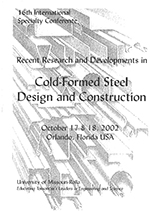Session Dates
17 Oct 2002
Abstract
The Direct Strength Method (DSM) has recently been developed by Schafer and Pekoz for the design of cold-formed steel structural members. What is now required is the calibration of the method against existing design methodologies for common structural systems such as roof and wall systems. The paper firstly explains the application of the DSM for the design of simply supported and continuous purlins. Some generalizations, such as how to handle combined bending and shear at the ends of laps, have had to be made to implement the method for continuous purlin systems. The method is then applied to study a range of section sizes in C- and Z-sections and a range of spans for simply supported, continuous and continuous lapped purlins. The results are compared with purlin design capacities to the Australian/New Zealand Standard AS/NZS 4600. This standard is similar to the AISI Specification except that it includes design rules for distortional buckling. Some modifications have had to be made to the strength equations in the DSM to achieve an accurate and reliable comparison. These modifications are included in the paper.
Department(s)
Civil, Architectural and Environmental Engineering
Research Center/Lab(s)
Wei-Wen Yu Center for Cold-Formed Steel Structures
Meeting Name
16th International Specialty Conference on Cold-Formed Steel Structures
Publisher
University of Missouri--Rolla
Document Version
Final Version
Rights
© 2002 University of Missouri--Rolla, All rights reserved.
Document Type
Article - Conference proceedings
File Type
text
Language
English
Recommended Citation
Quispe, Luis and Hancock, Gregory J., "Direct Strength Method for the Design of Purlins" (2002). CCFSS Proceedings of International Specialty Conference on Cold-Formed Steel Structures (1971 - 2018). 2.
https://scholarsmine.mst.edu/isccss/16iccfss/16iccfss-session8/2
Direct Strength Method for the Design of Purlins
The Direct Strength Method (DSM) has recently been developed by Schafer and Pekoz for the design of cold-formed steel structural members. What is now required is the calibration of the method against existing design methodologies for common structural systems such as roof and wall systems. The paper firstly explains the application of the DSM for the design of simply supported and continuous purlins. Some generalizations, such as how to handle combined bending and shear at the ends of laps, have had to be made to implement the method for continuous purlin systems. The method is then applied to study a range of section sizes in C- and Z-sections and a range of spans for simply supported, continuous and continuous lapped purlins. The results are compared with purlin design capacities to the Australian/New Zealand Standard AS/NZS 4600. This standard is similar to the AISI Specification except that it includes design rules for distortional buckling. Some modifications have had to be made to the strength equations in the DSM to achieve an accurate and reliable comparison. These modifications are included in the paper.



